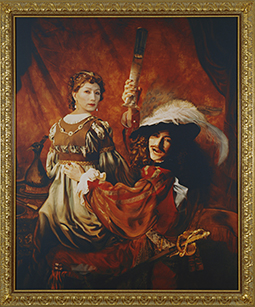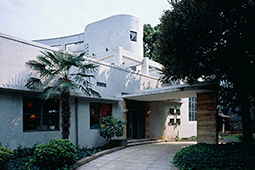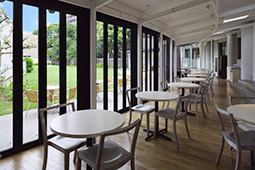 |
 |
 |
HOME > FOCUS > Revisiting Morimura, Rembrandt, and the Hara Museum |
 |
 |
Focus features two in-depth reviews each month of fine art, architecture and design exhibitions and events at art museums, galleries and alternative spaces around Japan. The contributors are non-Japanese art critics living in Japan. |
|
|
 |
 |
 |
Revisiting Morimura, Rembrandt, and the Hara Museum
Lucy Birmingham |
 |
|
|
|
|
Portrait of the Family - Wife (1994), color photograph on canvas, 120 x 100 cm, © Yasumasa Morimura |
|
Face Study III (1994), black and white photograph, 25 x 20 cm, © Yasumasa Morimura |
Yasumasa Morimura, well known for his satirical, gender-bending photographic self-portraits of famous personages (both men and women) and iconic paintings, is back at Tokyo's Hara Museum of Contemporary Art in his Rembrandt guise. These works, which were first exhibited at the Hara in 1994, are now showing under the title Yasumasa Morimura -- Rembrandt Room Revisited.
It's no wonder Morimura was inspired by the great 17th-century Dutch painter, etcher and draftsman. Known for his many self-portraits, Rembrandt was an early advocate of the concept of "self" in art.
With flawless detail, Morimura has transformed himself into Rembrandt, as well as the painter's wife, son, mother -- and the maid who became his lover and companion after his wife's death. Morimoto plays on the portrait historié of the The Prodigal Son in the Tavern while posing as Rembrandt posing as the Prodigal Son. It's Morimoto at his best, posing the question for us all: Who am I?
The works in the show are now part of the Hara Museum Collection amassed by Toshio Hara, the museum's founder and chairman. Hara is one of Japan's rare art pioneers.
|
 |
|
|
|
Self-Portrait as the Prodigal Son 1636 (1994), color photograph on canvas, 77 x 63 cm, © Yasumasa Morimura
|
It was the mid-1970s when he initially explored the idea of creating Japan's first private, residential-style contemporary art museum. He was already 40, but threw caution to the wind and began amassing a collection from scratch under the aegis of his newly formed Foundation Arc-en-Ciel.
He had been warned it would take 20 years before the museum would gain recognition. But four years later, when the Hara Museum opened in 1979, the unexpected happened: word spread rapidly. Art lovers flocked to see his unique contemporary art collection, as well as the intriguing Le Corbusier-inspired museum building with its café and green grounds -- a renovated family home.
"I was amazed the museum became known and evaluated very quickly," says Hara. "In those days, private museums in Japan like the Bridgestone Museum or Suntory Museum were usually located in a corner of a big corporate headquarters building. I was inspired by the private museums I visited in Europe that were small and often within a house."
The uniqueness of his collection was another big draw. Works by Andy Warhol, Robert Rauschenberg, Jasper Johns, and Roy Lichtenstein were among his early finds after introductions by art collector and friend John Powers. Photos show Hara traveling with the artists in the U.S. "I traveled with Warhol for several months," he recalls. One of Warhol's three Campbell's Tomato Soup Can sculptures is in his collection.
 |
|
 |
|
|
|
| The entrance to the Hara Museum in Shinagawa, Tokyo |
|
The Hara Museum garden |
Hara trusted his collecting instincts. "Private Japanese museums usually commission influential art critics or scholars to amass the collection. Owners don't feel confident about selecting the works," he explains. "In my case I didn't know much about collecting art. I wasn't an expert." He had been working in business management, but many people encouraged him. "They said the choice of artworks and artists had to be my decision -- otherwise the museum would be someone else's, not my own. So I always make the final decision myself."
Hara has what he calls a sensibility, his own sense of aesthetics. "I was told that everyone has this ability, but it's sleeping. We're not using it," he says. "This was quite true when I started associating with the artists and selecting their works. My sensitivity started to wake up, and move and grow."
|
 |
|
|
|
The café at the Hara Museum
All images are courtesy of the Hara Museum of Contemporary Art.
|
Much of his sensitivity was nurtured by a family steeped in cultural interests and international study. Toshio attended Princeton University (Class of 1960), where he studied business management for two years. He followed in the footsteps of his great-grandfather, the family patron Rokuro Hara (1842-1933), who studied economics and banking in England and at Yale. An influential founder of banks, railroads, and other businesses, Rokuro contributed to Japan's epoch-changing westernization process at the tumultuous turn of the 19th century. A connoisseur of Japanese waka poetry and calligraphy, he amassed the family's valuable collection of early-modern Japanese paintings, crafts, calligraphy, and Chinese art. Several works have been designated as National Treasures or Important Cultural Properties.
It was Toshio's grandfather, Kunizo Hara, who built the modernist home in 1938 on the family estate in Tokyo's Shinagawa district. The residence subsequently survived incarnations as the U.S. Occupation's officer headquarters after World War II, the Philippine and Ceylon (Sri Lankan) embassies, and the Japan Foreign Ministry official residence, before sitting uninhabited for almost 23 years until its rebirth as the Hara Museum.
"We only had about five staff at the start, and everyone would take turns serving visitors tea and coffee at the café. Maybe I served a few cups," Hara laughs. Visitors would have to ring the front doorbell to enter. Suddenly one day it was announced that Prime Minister Toshiki Kaifu would be making a visit. "He came wearing one of his famous polka-dot neckties," says Hara. "Some young people in the café were surprised and said, 'Kusama! Kusama!' He enjoyed our contemporary art."
In 1988 Hara opened the Hara Museum ARC annex in Shibukawa, Gunma Prefecture to store and display his growing collection, and commissioned permanent installations by Olafur Eliasson, Jean-Michel Othoniel, Federico Herrero, and Lee Bul. An extension, the Kankai Pavilion, was added in 2008 to display the Rokuro Hara Collection in honor of his great-grandfather. The entire museum complex was designed by architect Arata Isozaki, and is located about 90 minutes by train northwest of Tokyo.
Toshio Hara's distinctive approach can be felt throughout the two museums. Among the impressive exhibitions, gallery spaces, café, shop, and natural greenery of the Tokyo facility, one can sense the warmth of a well loved home. Remarkably, there is very little turnover in staff. The family tradition continues, delighting visitors from near and far.
 |
 |
Lucy Birmingham
Lucy Birmingham is a long-time, Tokyo-based journalist, scriptwriter, author, and former photojournalist. She currently serves as president of the Foreign Correspondents' Club of Japan. She writes regularly for TIME magazine and her articles have appeared in many publications, including the Wall Street Journal, Newsweek, Bloomberg News, and Architectural Digest. As an arts and culture writer her articles have appeared in publications including Artinfo.com, Artforum.com, and ARTnews. She is also a scriptwriter and narrator for NHK (Japan's public broadcaster) and has published several books including Strong in the Rain: Surviving Japan's Earthquake, Tsunami, and Fukushima Nuclear Disaster.
lucybirmingham.com |
|
 |
|
|
 |
|
 |
|